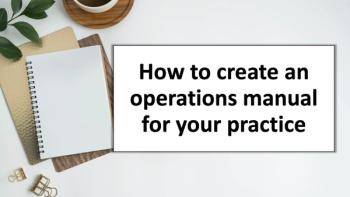
Operations: The Ins and Outs of Equipment Leasing
Leasing is sometimes the best way to get that expensive piece of equipment you need - especially when you negotiate favorable lease terms. Here's how.
When 10-year-old Steven Lessens wanted a bike, his father didn’t buy him one. Instead, he lent Steven the money and let him make payments. It was a valuable experience.
Years later, Steven - now a physician at Shelby Family Medical Center, a two-physician practice on Lake Michigan’s shoreline - wanted to lease hardware and software for a new EMR system for his practice. He knew what to do.
“I’m blessed by the fact that my father was a CPA,” Lessens says with a laugh. “I realize a lot of doctors are totally naïve. They have no idea what they are doing in this field.”
Lessens asked the right questions, but would you? If you’re like most physicians, the answer is probably no.
One size doesn’t fit all
The first thing to understand about equipment leases is that there is more than just one kind. There are as many types of leases as there are types of equipment.
Leases are usually 36 to 60 months long, and they almost always take effect over one-year increments. Depending on the total cost of the equipment you want to lease, you may be required to put up one or two months of payments in advance - or none at all. Like many things, it’s negotiable.
Nor is it always the case that bank loans have lower interest rates.
Leasing rates, especially for expensive equipment, are often very competitive. The higher the equipment’s price tag, the closer the lease’s interest rate will be to that of a bank loan. Lessens says the interest rate on his EMR lease “was somewhere around 7 percent.” His local bank couldn’t beat it.
In general, physicians looking to lease equipment for their practices are likely to encounter the following lease options:
The $1 purchase option lease. “We call those ‘buck-outs’ within the industry,” says Erik Jensen, senior vice president of Healthcare & Bank Leasing for Key Equipment Finance in Superior, Colo. The “buck-out” lease is simple: At the end of the lease’s term, the doctor has the option to purchase the equipment for $1 - no other charges attached.
“If a physician knows he is going to want to keep the equipment long term, he is going to have this very nominal amount at the end of the lease,” says Jensen. “So he’s going to know that there are no hidden fees or charges to own the asset long term.”
The fair market value lease. At the end of this lease, a physician can purchase the leased equipment for its “fair market value,” that is, what it would fetch if the used machine were sold to another doctor. This type of lease is typically available for equipment that holds its value over time, and it can sometimes be an economical option. “Because the leasing company takes what is called a ‘residual value’ in the equipment - or we feel it’s going to be worth something at the end of that period of time - so the doctor’s payments are lower,” explains Jensen.
But who decides what’s fair?
Jensen says an unscrupulous leasing company can cause big problems for physicians. “That leasing company really can hold them hostage for the fair market value of the equipment. Where it might really be worth 20 percent of its original value, the leasing company might … charge you 40 percent instead. … The doctor is powerless to do anything about that.”
If you go this route, ask your leasing company to write in the equipment’s fair market value at the end of the lease into your contract.
The true or operating lease. This is the lease most people are familiar with: You pay a fixed amount over a predetermined period, and then the leasing company takes the equipment back.
This is an especially good option for equipment that becomes technologically obsolete quickly and doesn’t hold much resale value. “If it’s the kind of equipment I know I’m not going to want to have at the end of three or five years, then I’m going to go for [a true lease],” says Jeffrey Milburn, vice president of managed care at Colorado Springs Health Partners, PC. Examples of typical equipment that is leased this way include office computers or servers, which need to be replaced regularly.
But leasing companies also charge more for this type of equipment. “If everyone thinks it’s going to be obsolete, they’re going to build that into the lease,” says Paul Angotti, president of Management Design, LLC, based in Monument, Colo. “[Leasing companies] are going to know that the equipment is going to be worth almost nothing at the end of the lease, and the lease payments will be higher.”
Getting started
Physicians who need to lease equipment and are pressed for time should get their practice managers involved. “The physician has to be very much involved in the selection [of equipment],” says Milburn. “But then you would get your manager or administrator involved to handle the technical financing aspects, review of the contract, do the comparative analysis of the terms, etc.”
The manager should determine the total cost of the lease, which isn’t always as easy as it sounds. “A lot of leases - like loans and even outright purchases - have all sorts of little, hidden costs,” warns Angotti.
Milburn recommends establishing the base cost of the product first. “Find out exactly what it would cost buying it just for cash, then try to negotiate that number. Try to get the actual cash cost of the extended warranty and service agreements.”
This is a good time to get your accountant involved to run financial projections and comparisons. An accountant can help determine the base cost and what revenue the equipment will generate. Look at the CPT codes the equipment will drive, and estimate how many of the corresponding procedures your practice now performs. Then look at what your payers reimburse you for those procedures. This total financial picture will give you an idea of the annual revenue you can expect to gain by leasing the equipment.
And don’t forget to factor in any additional staff or supplies that may be required to maintain the equipment.
The next step is to approach a leasing company. Most equipment manufacturers can refer you to different companies, but how do you know which ones to trust?
“The first thing I looked at was the relationship between [the leasing company and the equipment manufacturer],” says Lessens, who was concerned about financial reciprocity between the two companies. But established relationships don’t necessarily translate into financial impropriety.
“Most savvy equipment vendors … have a relationship with a leasing company or with a couple of leasing companies. They do that because they realize that physicians oftentimes do want to lease, so they want to provide one-stop shopping to the customer,” says Jensen. “[Vendors] hold us very accountable for our service levels, for our rates, for the way that we treat their customers. Because they know that we are, by default, an extension of their company. If we look bad, we make them look bad.”
Ask how long the leasing company you are considering has worked with a particular vendor. If the relationship is new, that doesn’t necessarily mean the leasing company is untrustworthy. But established relationships do usually indicate a history of satisfied customers. Large companies with corporate governance (e.g., those whose stocks are publicly traded) face a good deal of scrutiny through audits and compliance regulations, but there are also quite a few midlevel independent companies with excellent reputations. Be sure to ask about a company’s reputation among your colleagues.
Finally, watch out for lease brokers, who often sell leases to other companies. That means you have no control over who ends up owning your lease. “More often than not, if you have a fraud problem, if you have a misrepresentation problem … it’s going to be from a broker,” says Jensen. There are good brokers, but it can be hard to tell the bad from the good. To protect yourself, ask direct questions, such as: Are you a lease broker? Do you hold your own paper, or do you sell it? Will you sell my transaction?
Read the fine print
Make sure you read your entire lease contract before you sign it. Then go back and read it again. Some things to be on the lookout for include:
- Taxes - Who pays taxes on the leased equipment, and who gets any tax benefits? If sales tax is involved, check to see if it’s being figured into your payments. In some states you can claim depreciation of leased equipment, but in others you can’t; make sure you know how your state operates.
- Insurance - You need to have insurance coverage for the new equipment, and that cost comes out of your pocket. If you don’t carry insurance or choose not to purchase it, many lease contracts automatically add an insurance premium to your monthly payment. Most reputable leasing companies mark that premium up slightly to cover administrative costs, but some companies charge exorbitant fees for insurance. Examine how your lease addresses these costs.
- Indemnification - Imagine a scenario in which a patient is somehow injured during the routine use of leased medical equipment. The patient hires an attorney, and the attorney decides to sue everyone: you, the equipment vendor, and the leasing company. Many leasing companies now guard themselves against these legal actions by including indemnification clauses in their leases. Basically, these clauses state that the physician agrees to cover any legal costs associated with such lawsuits.
“The problem with an indemnification agreement is it’s like writing them a blank check,” says Milburn. “If the patient decides to sue [the leasing company], they’re going to run up some legal costs. … [Your] insurance isn’t going to cover what we call ‘contractual liability.’”
If you spot such a clause in your lease, ask your leasing company to remove it.
- Hidden costs and evergreens - It’s important to ensure you won’t be held liable for any extra costs at the termination of your lease. Some fair market value contracts provide for an extra penalty if the equipment is not worth the balance of the lease upon its termination and the physician declines to purchase it. Other leases impose additional penalties for damage to the equipment or depreciation that is greater than expected. Ask about any potential costs at a lease’s expiration.
You also need to watch out for “evergreen” provisions. When alease nears its end, a physician needs to choose whether to purchase the equipment or return it. If the physician doesn’t make a decision, the lease enters what is called “evergreen” status. Most leasing companies simply charge month by month until the physician reaches a decision, but some companies will automatically renew the lease for an additional six to 12 months if not instructed to do otherwise. Other companies require advance notice of your decision to purchase or not 90 to 120 days before the end of the lease. If you do not give notice, they may automatically lock you into the same lease for an additional six months.
And make sure you know all of your responsibilities before you sign anything. “You want to know the parameter for every amount of payment that you’d ever have to pay and how it’s calculated,” Angotti advises.
Robert Anthony, a former associate editor for Physicians Practice, has written for the healthcare and practice management industries for five years. His work has appeared in Physicians Practice, edge, Humana’s Your Practice, and Publisher’s Weekly. He is based in Baltimore, Md.
This article originally appeared in the September 2006 issue of Physicians Practice.
Newsletter
Optimize your practice with the Physicians Practice newsletter, offering management pearls, leadership tips, and business strategies tailored for practice administrators and physicians of any specialty.




